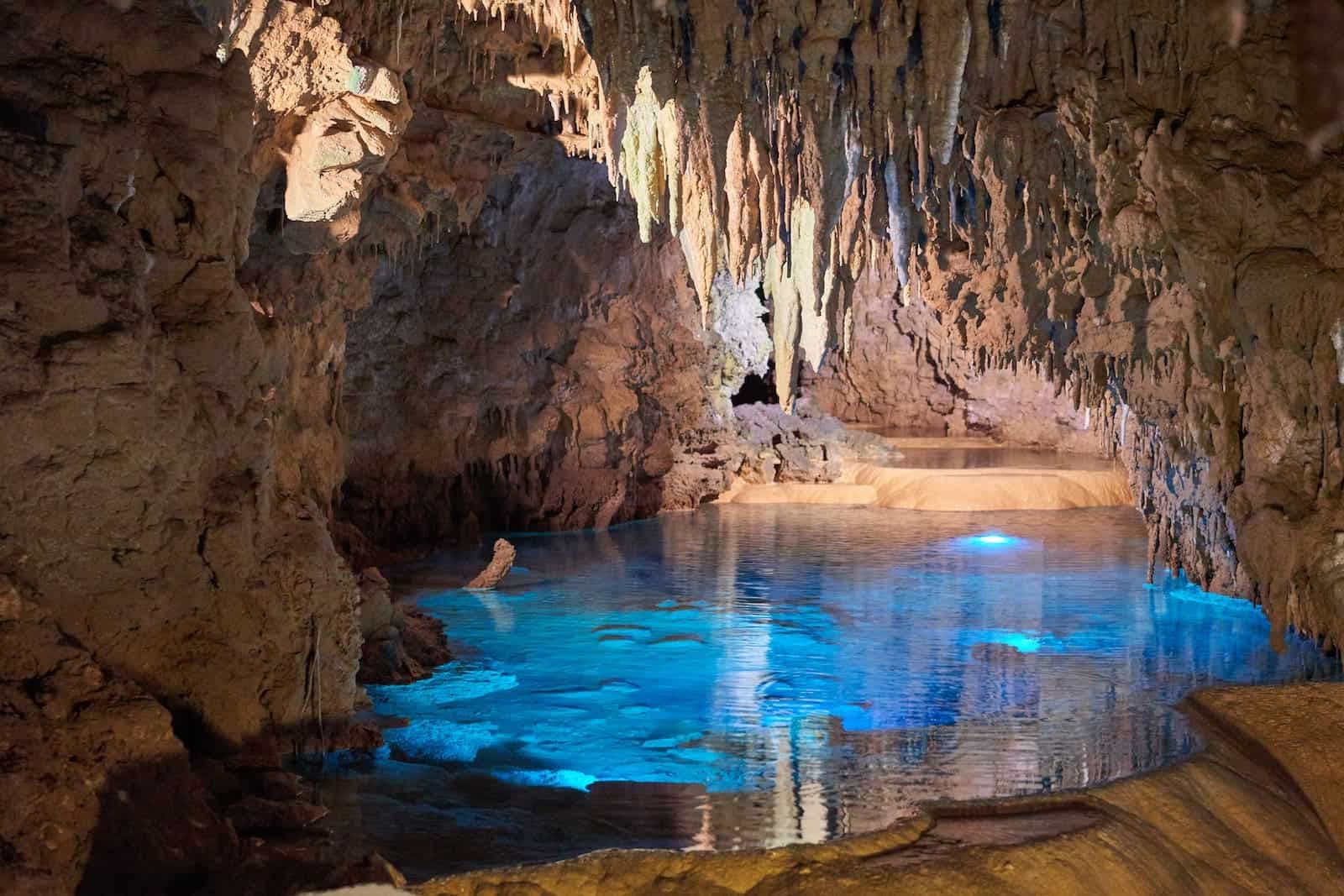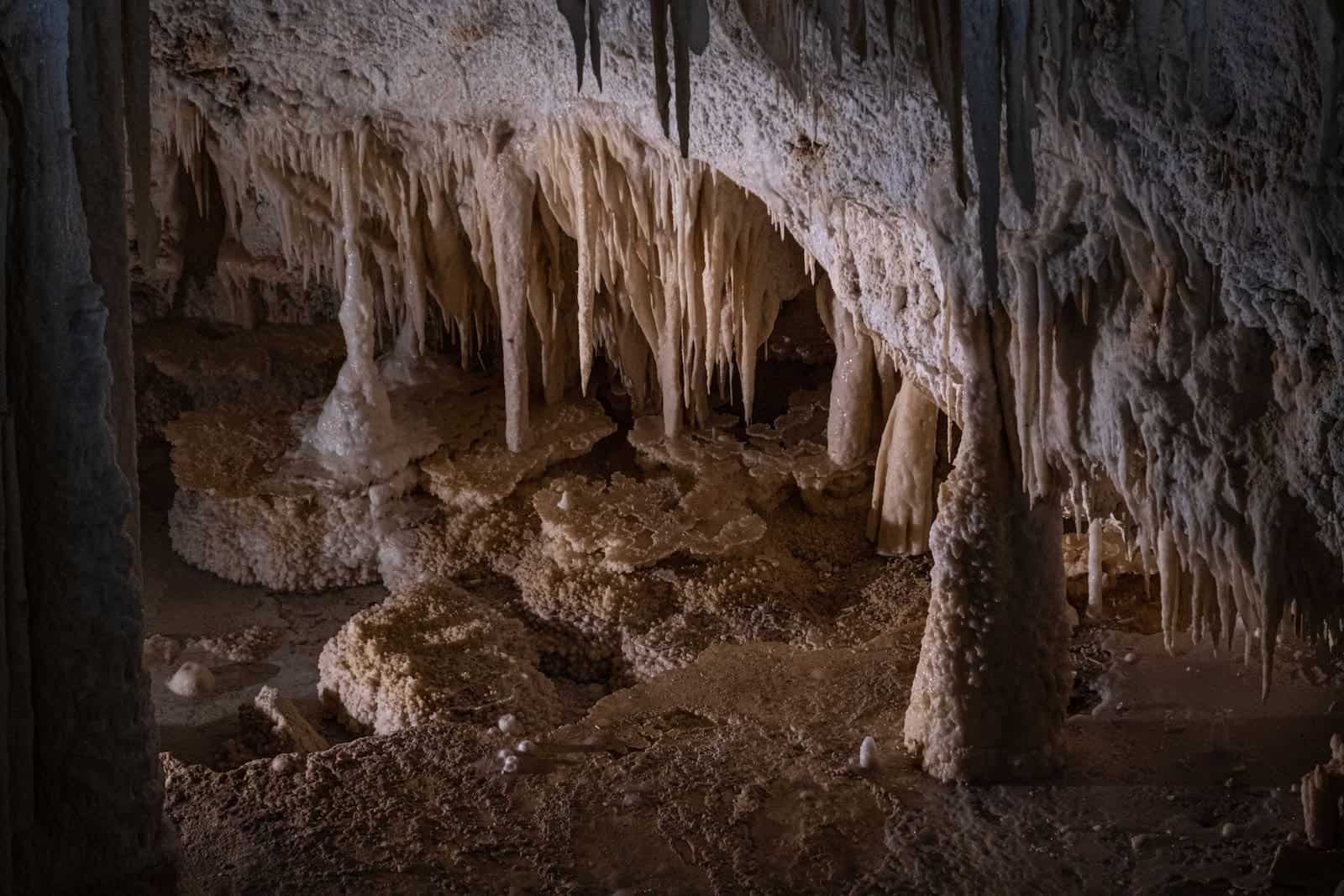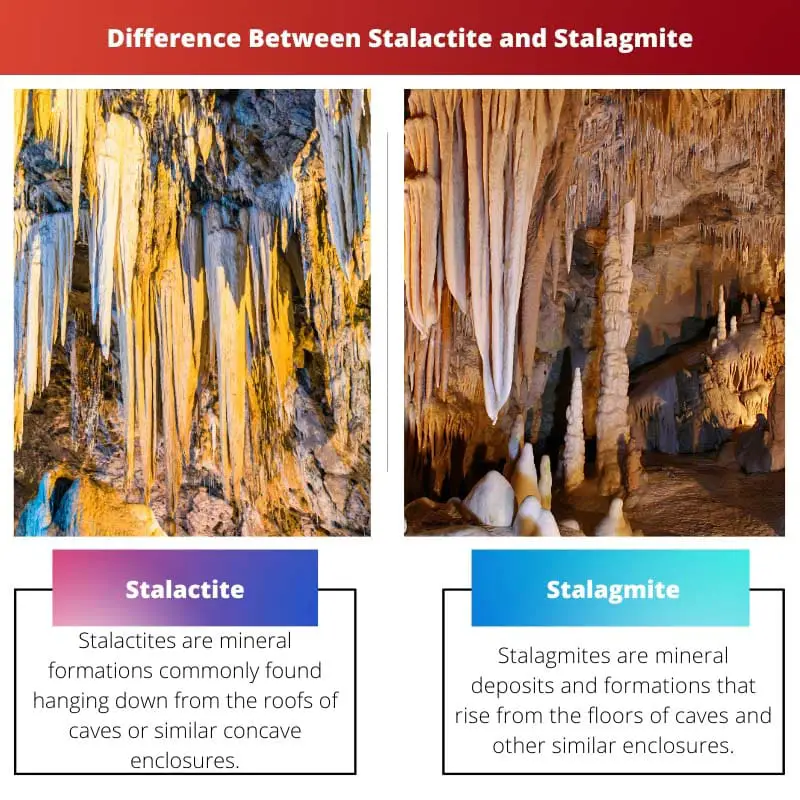Stalactite and stalagmite are pointy, pillar-like structures formed within caves with time. These formations are due to the activities of many different types of minerals that might be present within caves.
The minerals react with the moisture and the water that might be trapped inside the cave. Such caves could either be an open cave or an underground cave.
Key Takeaways
- Stalactites are icicle-shaped formations that hang from the ceilings of caves, while stalagmites are cone-shaped deposits that rise from the cave floor.
- Stalactites form through the slow dripping of mineral-rich water from the cave ceiling, while stalagmites grow from the accumulation of minerals that water deposits onto the cave floor.
- Both stalactites and stalagmites are examples of speleothems, mineral deposits created within caves through geological processes.
Stalactite vs Stalagmite
The difference between stalactite and stalagmite is that stalactite is a formation having a strong base from the roof of any cave and is practically dropping down or hanging from the cave ceiling. On the other hand, a stalagmite is a small pillar-like formation that happens because of minerals accumulating from the floor of a cave, which means the stalagmites rise from the base of a cave.

Stalactites are perceived to be dangerous when seen in crowded areas or tourist destinations as there are high chances of the hanging stalactite formation falling.
But this is unlikely as the mineral deposits are quite strong and happen in the most natural way possible with no human interference, making it as stable as possible.
Stalagmite is quite a feast for the eyes. This is because yards and yards of stalagmite look like they are all stable and a miniature sculpture of a city in the making.
The mineral formations are kept below and people admire them from overpasses that are kept for tourism purposes. And people aren’t scared of stalagmites as there are almost no chances of them hurting people.
Comparison Table
| Parameters of Comparison | Stalactite | Stalagmite |
|---|---|---|
| Unstable | Yes | Not always |
| Probability To Refract Light | High | Low |
| Position | On the ceiling or roof | On the ground |
| pH Is a Deciding Factor | No | Yes |
| Can Be Dirtied by Touch | Not always | Yes |
What is Stalactite?
Stalactites are mineral formations commonly found hanging down from the roofs of caves or similar concave enclosures. It is pretty to look at as it gives a surreal effect where the mineral formations might reflect and refract light rays that fall on it.
Stalactites are not just formed in caves. It can be seen in underground water holes, hot springs, and even in many man-made places. Structures such as bridges and underground passages with high moisture content are known to have stalactites hanging from them.
The main reason stalactites form is when minerals and other similar deposits that are soluble in liquid or even gaseous carbon dioxide form a colloidal suspension that accumulates.
These accumulated suspensions are not present as the hanging forms seen today as stalactites. But because of the humidity in such closed spaces, these solid suspensions melt downward, therefore, creating the stalactites hanging from the ceiling.
The minerals included in the formation of stalactites are sand, lava, peat, mud, etc. Atomic particles from such minerals react with the moisture in the closed places and melt. The most common type of stalactite is limestone.
It occurs in limestone mines and caves with limestone deposits. Calcium carbonate, which makes up the chemical composition of limestone, precipitates from liquid suspensions.
This precipitated form can dissolve in carbonated water or any moisture with a high carbon dioxide composition.
The reaction leads to the formation of a base called calcium bicarbonate. It travels to the roof of the cave or mine, leading to depositions and eventually melting down to form limestone stalactite.
But when calcium bicarbonate is subjected to air, it forms calcium carbonate. It releases carbon dioxide to create more stalactites and form a chain reaction. Similarly, with lava, mud, and sand, the same kind of chain reaction happens.
Each of these elements fills up an entire space with hanging stalactites.

What is Stalagmite?
Stalagmites are mineral deposits and formations that rise from the floors of caves and other similar enclosures. It stretches over large areas to create the facade of a mini-metropolis with sky-high skyscrapers.
Because of the material used to create them, stalagmites are a sight to behold. At times, there are chances of stalagmites being luminescent. The main reason stalagmites form is that many mineral deposits fall off the ceiling onto the floor, leading to deposition.
These are also called drippings. It is called “drippings” because the minerals drip off the ceiling onto the floor. But for the formation of stalagmites, the pH is of utmost importance.
It is why, in comparison to stalactites, we don’t see as much stalagmite formation in caves and mines. The most common kind is limestone stalagmite.
When calcium carbonate precipitates from a mixture of similar minerals, they dissolve in carbonated water to give calcium bicarbonate.
But this calcium bicarbonate is present in the roof of the cave. And it becomes easier for small mineral deposits to fall onto the ground. It helps in initiating the formation of stalagmite.
But the main thing about stalagmite formation is the volume or the partial pressure of calcium carbonate matter. It should be greater than that of carbon dioxide to form the calcium bicarbonate and further stalagmite.
It is easier to form stalagmite because of constant dripping falling off the roof from many different areas. Once a single stalagmite starts forming, it becomes the base of all other stalagmites.
It means that many other pillar-like stalagmites rise from a single stalagmite and acts as an inoculum. People are advised to stay away from the stalagmite as it could lead to the receding growth of the structures.
The oils and sebum present on the human body surface can lead to changes in the surface tension of the stalagmite, which might eventually collapse the structure. The color of a single stalagmite can also change when touched.
It is because the touch of humans has grit and dirt.

Main Differences Between Stalactite and Stalagmite
- While stalactites hang down from the roofs of caves and mines, stalagmites, on the other hand, rise from the floors of the caves and mines.
- It is not practical for humans to touch and contaminate stalactites as they are all placed at a distance, but humans can contaminate stalagmites as they are much closer and on the ground.
- The edges of stalactites are pointy and sharp. It is also brittle, but the edges of stalagmites are thick and blunt.
- Stalactite formation does not depend on the pH of the water and the other minerals included in the chain reaction, whereas in the case of stalagmite formation, the pH of the water is one of the main deciding factors for the formation of it.
- It is easier for humans to be hurt by stalactites as there are chances it might rain down on humans standing underneath it, but as stalagmites are on the floor, there are no such fears.





